Discover 11 hidden attractions, cool sights, and unusual things to do in Bennington (United States). Don't miss out on these must-see attractions: Bennington Battle Monument, First Congregational Church of Bennington, and Bennington Museum. Also, be sure to include Old Bennington Post Office in your itinerary.
Below, you can find the list of the most amazing places you should visit in Bennington (Vermont).
Table of Contents
Bennington Battle Monument

Monument in Bennington, Vermont. The Bennington Battle Monument is a 306-foot-high stone obelisk located at 15 Monument Circle, in Bennington, Vermont, United States. The monument commemorates the Battle of Bennington during the American Revolutionary War.
In that battle, on 16 August 1777, Brigadier General John Stark and 1,400 New Hampshire men, aided by Colonels Warner and Herrick of Vermont, Simonds of Massachusetts, and Moses Nichols of New Hampshire, defeated two detachments of General John Burgoyne's British army, who were seeking to capture a store of weapons and food maintained where the monument now stands. While the battle is termed the Battle of Bennington, it actually occurred about 10 miles (16 km) away, in Walloomsac, New York; the Bennington Battlefield, a U.S. National Historic Landmark, is entirely within the state of New York.
In 1877, a local historical society began to plan a monument for the battle's centenary, and considered many designs. One which called for a slender stone column only 100 feet (30 m) tall was showcased during the battle's centennial celebration, which was attended by President Rutherford B. Hayes. The committee eventually accepted J. Phillip Rinn's design with some changes. The monument's cornerstone was laid in 1887, and it was completed in November 1889 at a total cost of $112,000 (including the site). It is constructed of Sandy Hill Dolomite from present day Hudson Falls, New York, a blue-gray magnesian limestone containing numerous fossils. Dedication ceremonies were delayed until 1891, when President Benjamin Harrison attended the ceremonies and held a reception at the nearby Walloomsac Inn. Today the Bennington Battle Monument is a Vermont State Historic Site.
From its observatory level at 200 feet (61 m), which can be reached by elevator (but not the 417 stairs, which are closed), one can see Vermont along with the other U.S. states of Massachusetts and New York. A kettle captured from General Burgoyne's camp at Saratoga is visible in the monument along with a diorama of the second engagement, and information on how the monument was built. Statues of John Stark ("Live free or die"), Seth Warner, and other notables ornament the grounds.
The monument, while 10 miles (16 km) from the relevant battlefield, is located very close to what was once the site of the Catamount Tavern, where Ethan Allen and the Green Mountain Boys planned the capture of Fort Ticonderoga in 1775.[1]
Address: 15 Monument Cir, 05201 Bennington
First Congregational Church of Bennington

Congregational church in Bennington, Vermont. The First Congregational Church of Bennington, also known as the Old First Church, is a historic church in Old Bennington, Vermont. The congregation was organized in 1762 and the current meeting house was built in 1805. The building, one of the state's best examples of Federal period religious architecture, was added to the National Register of Historic Places in 1973.[2]
Bennington Museum
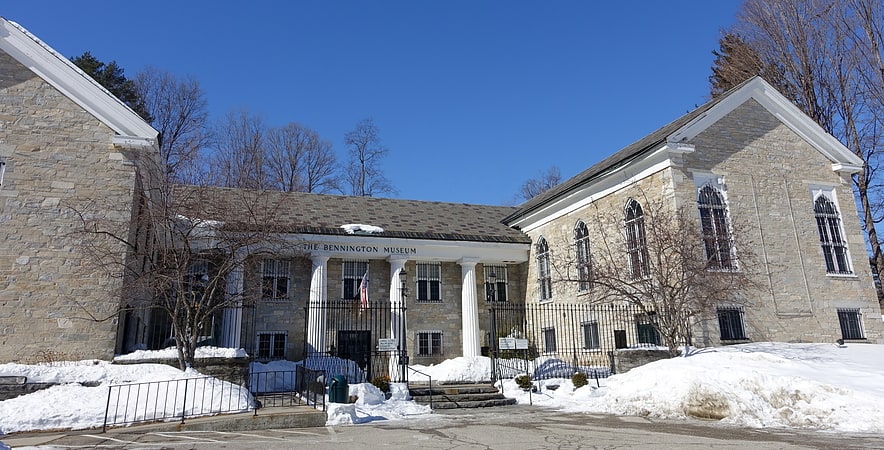
Museum in Bennington, Vermont. The Bennington Museum is an accredited museum with notable collections of art and regional history. It is located at 75 Main Street, Bennington, Vermont, USA.
The museum's history dates to 1852 when the Bennington Historical Association was first incorporated. In 1923 the association acquired a former church, which it renovated and opened to the public in 1928 as the Bennington Historical Museum. The building was subsequently expanded in 1938, 1960, 1974, and 1999. In 1938 its name was revised to the Bennington Historical Museum and Art Gallery to reflect its holdings of artwork, and in 1954 it was renamed the Bennington Museum. The collections have a special focus on Vermont and adjacent areas of New York and Massachusetts. In 1972 the schoolhouse attended by Grandma Moses was moved to the grounds and included as part of the museum. It also includes a genealogy and history research library.
Key aspects of the museum's permanent collections include:
- Grandma Moses Gallery - the largest public collection of paintings by noted local artist "Grandma Moses", Anna Mary Robertson Moses (1860-1961).
- Fine Art Gallery - including works by Ralph Earl, Oliver Tarbell Eddy, Erastus Salisbury Field, Ammi Phillips, William Morris Hunt, Frederick MacMonnies, Rockwell Kent, and Simon Moselsio.
- Bennington Modernism - avant-garde artworks from the early 1950s through the mid-1970s by artists including Pat Adams, Willard Boepple, Anthony Caro, Paul Feeley, Helen Frankenthaler, Patricia Johanson, Vincent Longo, Kenneth Noland, Jules Olitski, Dan Shapiro, David Smith, and Tony Smith.
- Gilded Age Vermont - focused on Bennington from the mid 1800s to mid 1900s. Exhibits include paintings by William Morris Hunt, Frederick MacMonnies’ portrait painting of May Suydam Palmer, and glass and metal works by Lewis Comfort Tiffany, as well as a parlor organ manufactured by the Estey Organ Company and the Martin Wasp, a luxury automobile made in Bennington in 1924-25.
- Military Gallery - focusing on the Revolutionary War's Battle of Bennington, and including an exhibit of Vermont-made firearms from 1760 to 1900.
- Bennington Pottery - featuring pieces by Norton Pottery (1785-1894), United States Pottery Company (1847-1858), Fenton pottery, and redware.
- Textile Gallery - the Bennington flag, one of the oldest “stars and stripes” in existence, a Green Mountain Boys flag belonging to John Stark, the Jane Stickle Quilt, and other textiles.
The museum also displays temporary exhibits on a wide variety of subjects.[3]
Address: 75 Main St, 05201 Bennington
Old Bennington Post Office
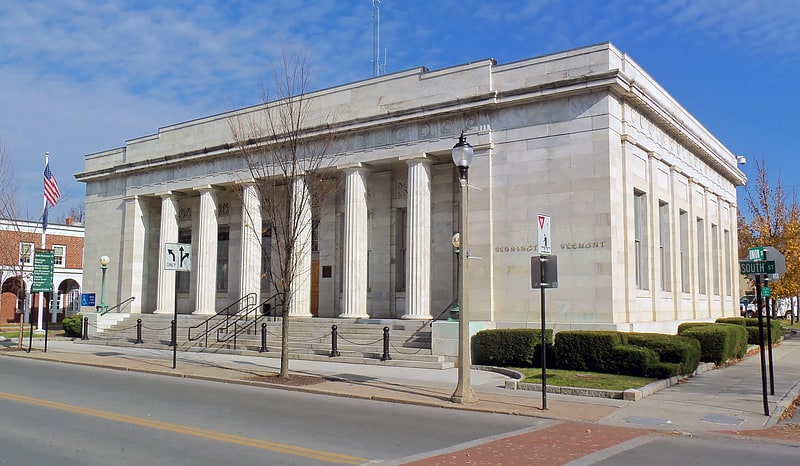
Post office in Bennington, Vermont. The Old Bennington Post Office is a historic government building at 118 South Street in Bennington, Vermont, United States. Also known at one time as the U.S. Federal Building, it is a Greek Revival building built in 1914, and now houses the Bennington Police Department. It was listed on the National Register of Historic Places in 1976 for its architecture.[4]
Paper Mill Village Bridge
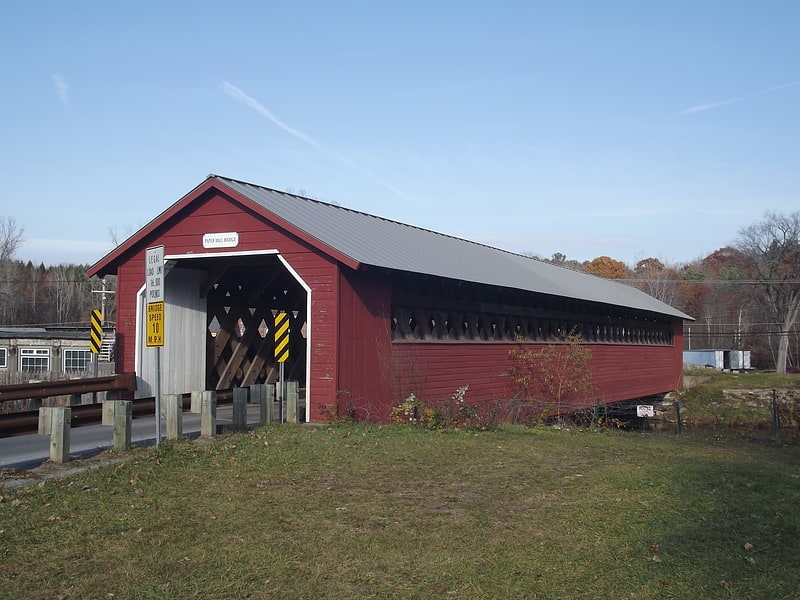
Covered bridge in Bennington County, Vermont. The Paper Mill Village Bridge, also called the Paper Mill Bridge or Bennington Falls Covered Bridge, is a wooden covered bridge that carries Murphy Road across the Walloomsac River northwest of Bennington, Vermont. Built in 1889, it was listed on the National Register of Historic Places in 1973.[5]
Address: Murphy Road, 05201 Bennington
Burt Henry Covered Bridge
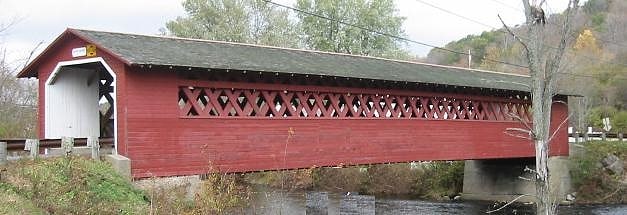
Covered bridge in the Bennington County, Vermont. The Burt Henry Covered Bridge, also known as the Henry Covered Bridge or just the Henry Bridge, is a covered bridge that spans the Walloomsac River near Bennington, Vermont. A Town lattice truss bridge, it carries River Road, just south of the village of North Bennington. Originally built about 1840, it was listed on the National Register of Historic Places in 1973 as Bennington County's oldest covered bridge. It was rebuilt in 1989 by the Vermont Agency of Transportation.[6]
Address: Murphy Road, 05257 Bennington
Old Bennington
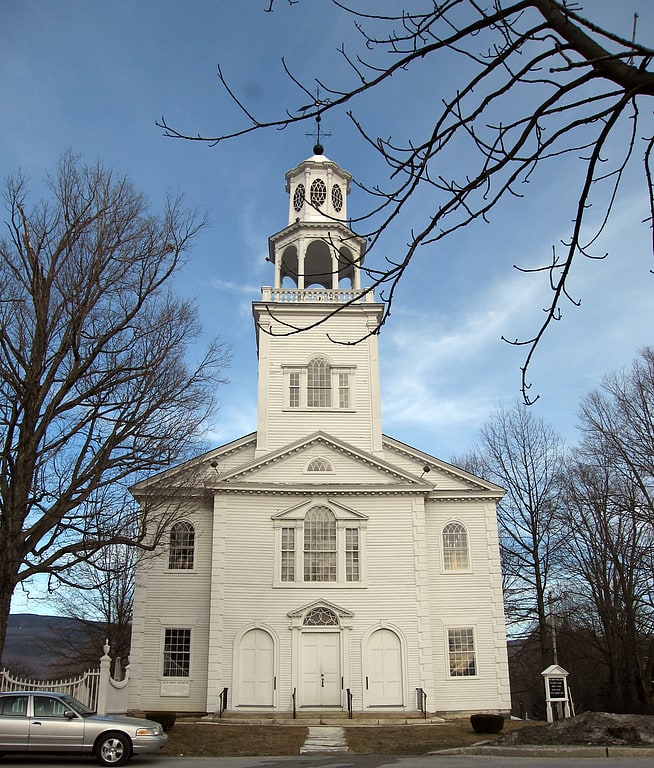
Village in Vermont. Old Bennington is a village in Bennington County, Vermont, United States. It is located entirely within the town of Bennington. As of the 2020 census, the village had a population of 156.
The village and its surrounding area were added to the National Register of Historic Places in 1984 as Old Bennington Historic District. It is roughly bounded by the former Rutland railroad bed, Monument Avenue, West Road, Seminary Lane, Elm Street, and Fairview Street. The district is noted for its well-preserved Revolutionary War-era homes, and is significant as one of the earliest settlements in Vermont. The centerpieces of the district are the Old First Church (built in 1806 and restored in 1937) and the Bennington Battle Monument. Robert Frost, his wife Elinor Miriam White Frost, and their children are buried in the cemetery behind the Old First Church.[7]
Silk Covered Bridge

Covered bridge in the Bennington County, Vermont. The Silk Covered Bridge is a covered bridge, carrying Silk Road across the Walloomsac River between downtown Bennington, Vermont and the village of North Bennington. A Town lattice truss bridge, it was built in 1840, and is one of three covered bridges across the river in fairly close proximity. It was added to the National Register of Historic Places in 1973.[8]
Park–McCullough Historic House
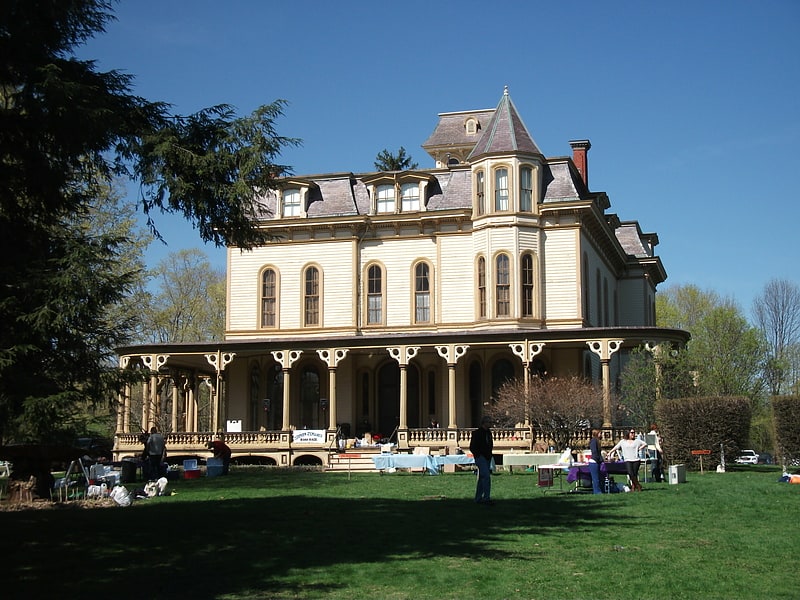
Historical place museum in the Bennington County, Vermont. The Park–McCullough Historic Governor's Mansion is one of the best-preserved Victorian mansions in New England. It is a thirty-five room mansion, set on 200 acres of grounds, and located off Vermont Route 67A in North Bennington, Vermont, USA.
The house was built in 1864–65 by attorney and entrepreneur Trenor W. Park (1823–1882), who was born in nearby Woodford, Vermont but amassed his fortune overseeing the mining interests of John C. Fremont in California. It was designed by Henry Dudley, a prolific New York architect of the popular firm of Diaper and Dudley. The house cost $75,000 and the family moved in on Christmas Day, 1865. His descendants made extensive renovations to the house in 1889–90, largely in order to entertain President Benjamin Harrison who had come to town to dedicate the new Bennington Battle Monument.
The Park–McCullough Historic Governor's Mansion is an important example of an American country house in the Second Empire Style. It also incorporates architectural features of the Romantic Revival style popular at the time.
The house is now owned by a non-profit organization and is open to the public.[9]
Address: 1 Park St, PO Box 388, Bennington
Bennington Free Library

Public library in Bennington, Vermont. Bennington Free Library is a public library located at 101 Silver Street in Bennington, Vermont.[10]
Address: 101 Silver St, Bennington
Bennington

Tourist attraction in Bennington, Vermont. The Downtown Bennington Historic District encompasses the historic commercial heart of Bennington, Vermont. Centered on the junction of Main, South, and North Streets, it exhibits a variety of commercial architectural styles from the early 19th to mid-20th century. It was listed on the National Register of Historic Places in 1980, and was enlarged in 2008.[11]